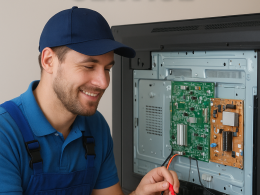As the global energy sector rapidly shifts towards renewable sources, solar farms have become a cornerstone of sustainable power generation. Ensuring the safety, reliability, and efficiency of these solar installations is paramount, and a critical aspect of this is the proper design and maintenance of their earthing systems. Integrating earthing testing services for substation design projects into solar farm services is essential to enhance performance, protect equipment, and ensure personnel safety.
This article explores the significance of professional earthing testing and commissioning solutions, particularly in the context of solar farm services, while highlighting how advanced technologies like 3D digital substation systems and comprehensive high voltage earthing testing contribute to power system safety and operational excellence.
The Importance of Earthing in Solar Farm Services
Earthing, or grounding, is the process of connecting electrical installations to the earth to prevent hazardous voltages during faults or lightning strikes. In solar farms, where vast arrays of photovoltaic panels and associated electrical infrastructure operate under high voltage, a reliable earthing system is vital.
Proper earthing protects equipment from damage, reduces the risk of electrical shock to personnel, and ensures the correct operation of protection and control systems. Given the complexity and scale of solar farms, earthing testing and maintenance in solar farm services is indispensable for verifying that the earthing system performs as designed.
Professional Earthing Testing and Commissioning Solutions
Professional earthing testing and commissioning solutions encompass a range of diagnostic and verification activities performed during the design, construction, and operational phases of solar farms and substations. These services typically include:
-
Fall-of-Potential (FoP) Tests: To measure earth resistance and validate the effectiveness of the grounding system.
-
Soil Resistivity Testing: To assess the earth’s conductivity and inform earthing system design.
-
Clamp-On Testing: A non-intrusive method to measure earth resistance without disconnecting earth electrodes.
-
Current Injection Testing: To simulate fault conditions and analyze potential rise and current distribution within the earthing grid.
These tests ensure compliance with international safety standards and help identify any deficiencies that could compromise system safety or performance.
High Voltage Earthing Testing for Power System Safety
Solar farms often include high voltage substations that step up the generated power for transmission. High voltage earthing testing for power system safety is critical in these areas to verify that the earthing system can safely dissipate fault currents and maintain operational integrity.
Such testing examines parameters like grid potential rise, step and touch voltages, and voltage contours. These factors are vital to prevent dangerous voltage levels that could cause equipment failure or pose risks to personnel.
Comprehensive Earthing Testing in High Voltage O&M Operations
Operations and Maintenance (O&M) of solar farms require ongoing comprehensive earthing testing in high voltage O&M operations to ensure the earthing system remains effective over time. Environmental factors like soil moisture, corrosion, and mechanical damage can degrade earthing performance.
Regular testing during O&M phases helps detect issues early, enabling timely maintenance and preventing costly downtime or safety incidents.
Earthing Testing for Protection and Control Systems in Substations
Protection and control systems rely heavily on accurate earthing to operate correctly during faults. Earthing testing for protection and control systems in substations verifies that the grounding network supports reliable fault detection and isolation.
Fault currents must be safely routed through the earthing system to trigger protective relays and circuit breakers. Testing ensures these pathways are intact and meet design specifications.
Advanced Earthing Testing with 3D Digital Substation Technology
The integration of advanced earthing testing with 3D digital substation technology represents a significant leap forward in substation design and maintenance. Digital twins and 3D modeling allow engineers to simulate earthing system performance under various scenarios, optimize design, and predict potential issues before physical implementation.
During commissioning, 3D digital substation tools facilitate precise mapping of earthing grids and enable real-time monitoring of earthing parameters, enhancing diagnostic accuracy and operational efficiency.
Power System Analysis Including Earthing Testing and Diagnostics
Comprehensive power system analysis including earthing testing and diagnostics provides a holistic view of solar farm electrical networks. This analysis evaluates the interaction between earthing systems, protective devices, and overall grid stability.
By combining earthing test data with system modeling, engineers can optimize protection schemes, improve fault response, and enhance system resilience.
Earthing Testing and High Voltage Testing for Electrical Substations
Electrical substations in solar farms require rigorous earthing testing and high voltage testing for electrical substations to validate insulation integrity, grounding effectiveness, and equipment safety. High voltage testing complements earthing tests by verifying that insulation systems withstand operational and transient voltages.
Together, these tests ensure substations meet safety standards and operate reliably under all conditions.
Reliable Earthing Testing During Testing and Commissioning Phases
The reliable earthing testing during testing and commissioning phases of solar farm projects is crucial to certify that the earthing system is installed correctly and functions as intended. Commissioning tests provide baseline data for future maintenance and confirm compliance with design specifications.
Accurate and dependable earthing testing at this stage mitigates risks, facilitates regulatory approvals, and lays the foundation for long-term operational safety.
Integrating Earthing Testing into Solar Farm Services: Benefits and Best Practices
Integrating earthing testing into solar farm services offers numerous benefits:
-
Enhanced Safety: Proper earthing minimizes electrical hazards to personnel and equipment.
-
Improved Reliability: Verified earthing systems reduce downtime caused by electrical faults.
-
Regulatory Compliance: Testing ensures adherence to national and international safety standards.
-
Optimized Performance: Accurate earthing supports effective protection and control system operation.
-
Cost Savings: Early detection of earthing issues prevents expensive repairs and operational disruptions.
Best practices for integrating earthing testing include early involvement during substation design, using advanced testing methodologies, leveraging digital substation technologies, and establishing routine maintenance schedules.
Conclusion
As solar farms continue to expand globally, ensuring the safety and reliability of their electrical infrastructure is paramount. Integrating earthing testing services for substation design projects into solar farm services is essential for achieving this goal. Through professional earthing testing and commissioning solutions, including high voltage earthing testing, power system analysis, and advanced 3D digital substation technology, solar farm operators can safeguard their investments and personnel.












